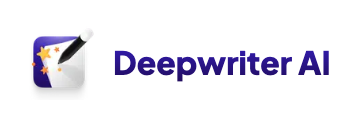AI tools are transforming medical research by automating literature reviews, analyzing data, and streamlining workflows. Here’s a quick breakdown of the top tools available today:
- DeepWriter: Creates detailed, citation-rich drafts tailored for publication. Plans start at $29/month.
- ScholarAI: Connects to academic databases like PubMed for automated literature insights. Works as a ChatGPT-4 plugin.
- Elicit: Simplifies systematic reviews with semantic search and customizable data extraction. Free tier available.
- SciSpace: Summarizes research papers and supports manuscript preparation. Free tier available.
- Scite: Analyzes citation contexts to validate research claims. Subscription starts at $8.40/month.
- Iris.ai: Processes large datasets with advanced workflows. Pricing is custom.
- ResearchRabbit: Visualizes connections between papers, authors, and topics. Free to use.
- Paperpal: Polishes manuscripts with grammar and style corrections. Premium plan costs $9.91/month.
- Covidence: Streamlines systematic reviews and meta-analyses. Institutional pricing applies.
- Aidoc: Focuses on real-time imaging analysis for radiology research. Enterprise pricing.
Each tool has unique strengths, from automating literature reviews to improving manuscript quality. Choose based on your research needs, budget, and compliance requirements. Below is a quick comparison of features and costs.
Quick Comparison
| Tool | Core Use | Pricing | Free Option | Key Feature |
|---|---|---|---|---|
| DeepWriter | Draft generation | $29/month+ | No | Long-form, citation-heavy drafts |
| ScholarAI | Literature search | Varies | No | PubMed integration |
| Elicit | Systematic reviews | Free + paid plans | Yes | Semantic search |
| SciSpace | Paper summaries | Free + paid plans | Yes | Literature analysis |
| Scite | Citation validation | $8.40/month+ | Yes (limited) | Contextual citation analysis |
| Iris.ai | Research workflows | Custom pricing | No | Large dataset processing |
| ResearchRabbit | Visual literature mapping | Free | Yes | Interactive research diagrams |
| Paperpal | Manuscript editing | $9.91/month | Yes | Grammar/style corrections |
| Covidence | Systematic reviews | Institutional | No | Blinded screening |
| Aidoc | Imaging analysis | Enterprise | No | Real-time imaging insights |
Start with free tools like ResearchRabbit or Elicit for basic tasks. For more specialized needs, consider premium options like DeepWriter or Covidence.
1. DeepWriter
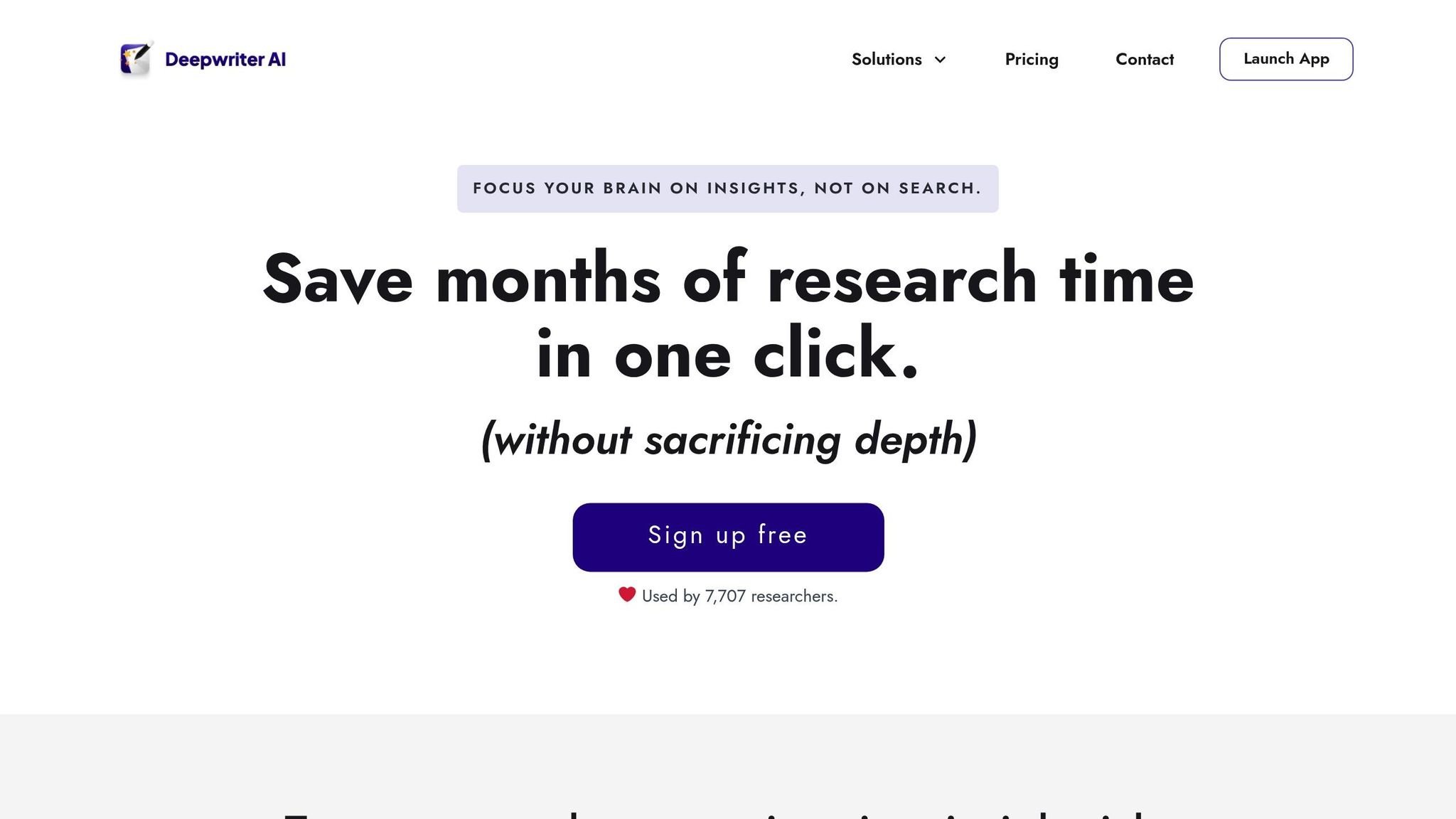
DeepWriter is designed to deliver expert-level, fully cited drafts in record time. It uses the Abraxas engine, a sophisticated multi-agent system that gathers evidence, cross-checks facts, and resolves discrepancies.
Core Functions
At its core, DeepWriter scans reliable sources and connects the dots through structured reasoning. Its multi-agent system works on various aspects of research simultaneously, cutting down what could take months of manual effort into a streamlined, comprehensive analysis.
This technical foundation powers features that cater to the demands of rigorous research.
Key Features
DeepWriter generates documents that are ready for publication, complete with verifiable citations and no fabricated information. It handles up to 275 pages of detailed, coherent writing and can automatically create tables, charts, and diagrams. With just a click, you can export your work to PDF, Word, or LaTeX formats.
Pricing
DeepWriter offers flexible plans to suit different research needs and volumes:
| Plan | Monthly | Yearly | Tokens/Month | Max Pages | Key Features |
|---|---|---|---|---|---|
| Starter | $39.00 | $29.00 | 55 (rollover to 165) | 165 | Citations, visuals, priority support, API |
| Plus | $79.00 | $59.00 | 130 (rollover to 390) | 275 | All Starter features with higher limits |
| Pro | $169.00 | $129.00 | 300 (rollover to 900) | 275 | Maximum capacity for extensive research |
The token rollover system allows unused tokens to accumulate, making it easier to tackle larger projects. Opting for annual billing also provides substantial savings – for example, the Pro plan saves you $480 per year. Additionally, API access is included in all plans, enabling seamless integration into institutional workflows.
2. ScholarAI

ScholarAI is reshaping the way medical researchers explore and analyze scholarly literature. By leveraging AI, this tool connects directly to PubMed and other leading academic databases, providing precise insights that help streamline research processes[1].
Core Functions
ScholarAI is designed to save time and effort by automating the discovery of relevant medical literature. It scans publications to pinpoint studies that address specific research questions. Its summarization feature is particularly useful, breaking down dense academic papers into concise overviews. This allows researchers to quickly identify which studies are worth delving into further.
Another standout feature is its interactive Q&A function. Instead of manually combing through lengthy texts, users can ask targeted questions about methodologies, results, or conclusions and get direct answers, simplifying the research process even more.
Key Features
This tool is particularly adept at handling medical inquiries, making it a go-to resource for specialized fields. It translates complex academic content into practical insights that support evidence-based decision-making, speeding up tasks like literature reviews and hypothesis development.
For those using ChatGPT-4, ScholarAI serves as a specialized plugin, seamlessly integrating into broader AI-assisted workflows. This connection enhances research capabilities, allowing users to perform focused literature analysis alongside other tools[2]. Together, these features solidify ScholarAI as a valuable asset for modern research workflows.
3. Elicit

Elicit is an AI-powered tool designed to make systematic reviews and meta-analyses in medical research more efficient. By simplifying literature research tasks, it supports evidence-based inquiries and smooths clinical research workflows.
Core Functions
With Elicit, you can submit a research question and have the tool extract essential details like sample sizes, methodologies, outcomes, and statistical findings.
Its semantic search goes beyond exact keyword matches. For example, a query like "cardiovascular interventions" will also bring up related concepts and terminology, ensuring that important studies aren’t missed due to differences in academic phrasing.
Elicit also creates paper summaries, focusing on critical elements like methodologies, primary findings, and study limitations – offering researchers a quick yet thorough understanding of each study.
Key Features
Elicit offers a range of tools to streamline the research process:
- Automatic extraction of structured data from research articles.
- Semantic search that identifies related concepts, not just exact matches.
- Paper summaries highlighting methodologies, findings, and limitations.
- Customizable data extraction tables for consistency across studies.
- Citation analysis to trace how research builds on previous work.
- Integration with reference management tools for smoother transitions to formal reviews.
Pricing
Elicit operates on a freemium model. The free tier includes core search and summarization tools, while subscription plans unlock advanced features for more detailed data extraction and large-scale research projects. Institutions can also access tailored pricing options.
4. SciSpace

SciSpace (formerly known as Typeset.io) is designed to simplify the process of reviewing academic literature and preparing manuscripts by breaking down complex research papers into clear, digestible insights.
Core Functions
SciSpace streamlines the research process by offering instant paper summaries, AI-powered literature searches, and citation tracking. These tools make it easier to conduct thorough reviews and stay organized throughout the research journey [1].
Key Features
The platform includes tools like PDF reading assistance, writing support, and collaborative features. It also integrates directly with Zotero, making literature organization more efficient [1][2]. SciSpace is particularly useful for research teams, especially those working across institutions, as it supports seamless collaboration. By combining AI-driven summarization with literature exploration, the platform is especially helpful for tackling research topics that span multiple disciplines [1].
5. Scite
Scite takes a fresh approach to citation analysis by using AI to validate scientific claims. Instead of merely tallying citations, it evaluates whether studies support, contradict, or simply reference earlier findings, offering a clearer picture of research reliability.
Core Functions
What sets Scite apart is its knack for analyzing the context of citations. This helps researchers follow the progression of medical knowledge and pinpoint studies that have stood the test of scientific scrutiny. By diving into the full texts of citing studies, Scite allows users to quickly assess whether a treatment, diagnostic tool, or research conclusion has been backed or questioned by subsequent work. This makes it easier to gauge the strength of evidence behind scientific claims [1][3]. These insights power Scite’s standout features, described below.
Key Features
The platform’s "Smart Citations" feature goes beyond traditional metrics by showing whether a paper’s claims are supported, disputed, or merely mentioned in other research. Researchers can refine their searches by study type, journal quality, or citation strength. Plus, Scite supports exporting reference libraries in BibTeX or RIS formats, making it compatible with most citation management tools [3].
Pricing
Scite provides a free plan with limited access to Smart Citations and search features for seven days – perfect for exploring the platform. For more robust research needs, the Scite Assistant (Pro) plan costs about $8.40 per month. This plan includes unlimited Smart Citations, detailed citation contexts, paper libraries, and advanced search options [3]. It’s a budget-friendly choice for individual researchers or small teams conducting in-depth literature reviews or systematic studies.
6. Iris.ai
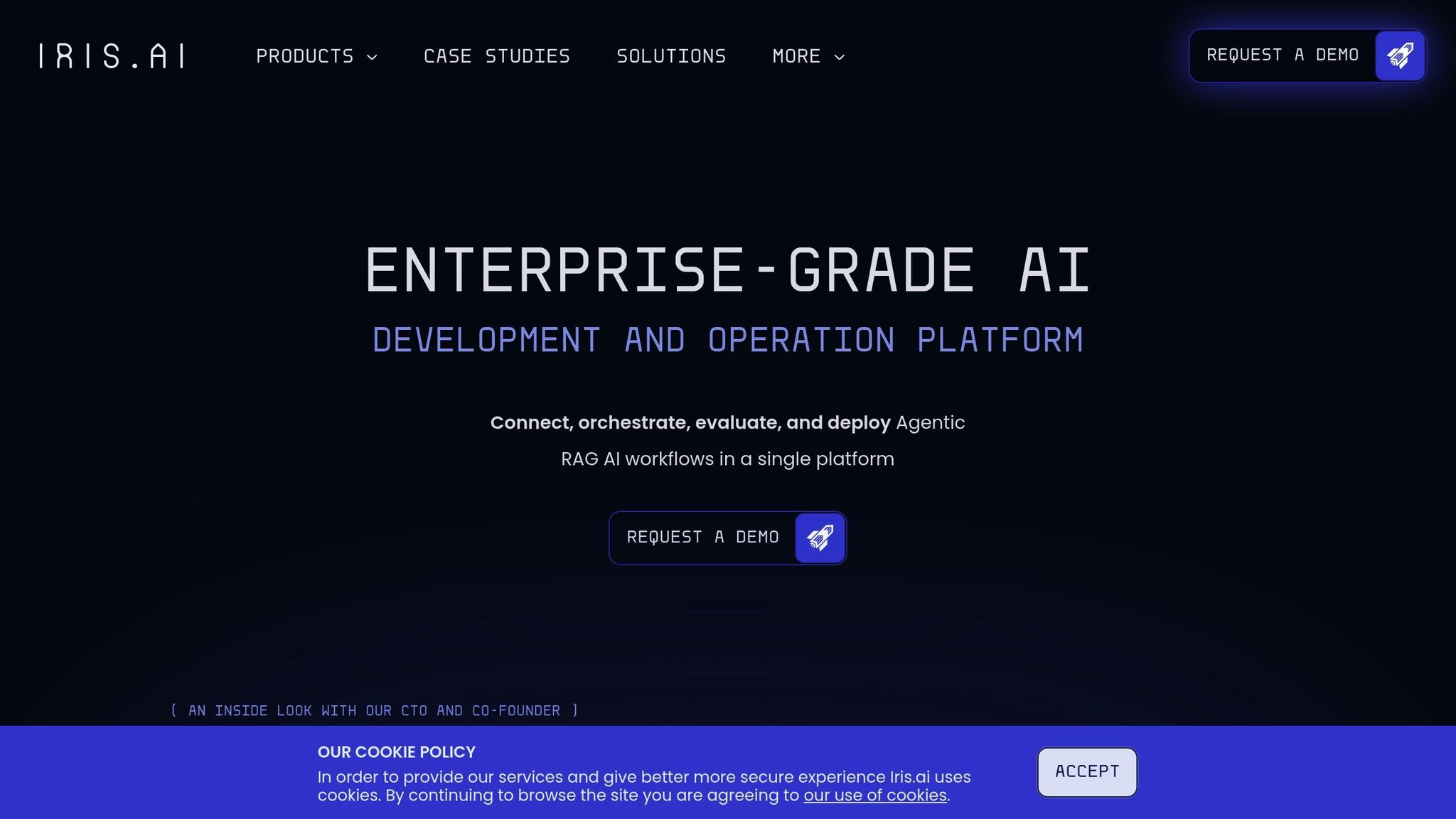
Iris.ai is a powerful AI platform tailored for enterprise use, designed to create and manage advanced Agentic RAG AI workflows. These workflows offer a sophisticated way to process and analyze external research data. For medical researchers dealing with overwhelming amounts of literature, Iris.ai provides an efficient solution to navigate complex datasets and quickly identify the most relevant studies. Its RSpace interface takes this a step further, offering a streamlined tool for filtering through scientific literature with ease.
Core Functions
At the heart of Iris.ai is its RSpace product, a robust interface that helps researchers efficiently explore vast collections of scientific literature. With rapid access to the latest research, it aids in bridging knowledge gaps in dynamic and evolving medical fields. Impressively, the platform has securely ingested over 160 million documents and evaluated more than 200,000 answers across 50+ use cases[4].
Key Features
What sets the RSpace product apart is its ability to go beyond simple keyword searches. Using context-based analysis, it understands the relationships and nuances within scientific literature. This makes it especially useful for researchers tackling challenges like emerging health threats, rare diseases, or interdisciplinary studies, where deeper insights are critical.
7. ResearchRabbit
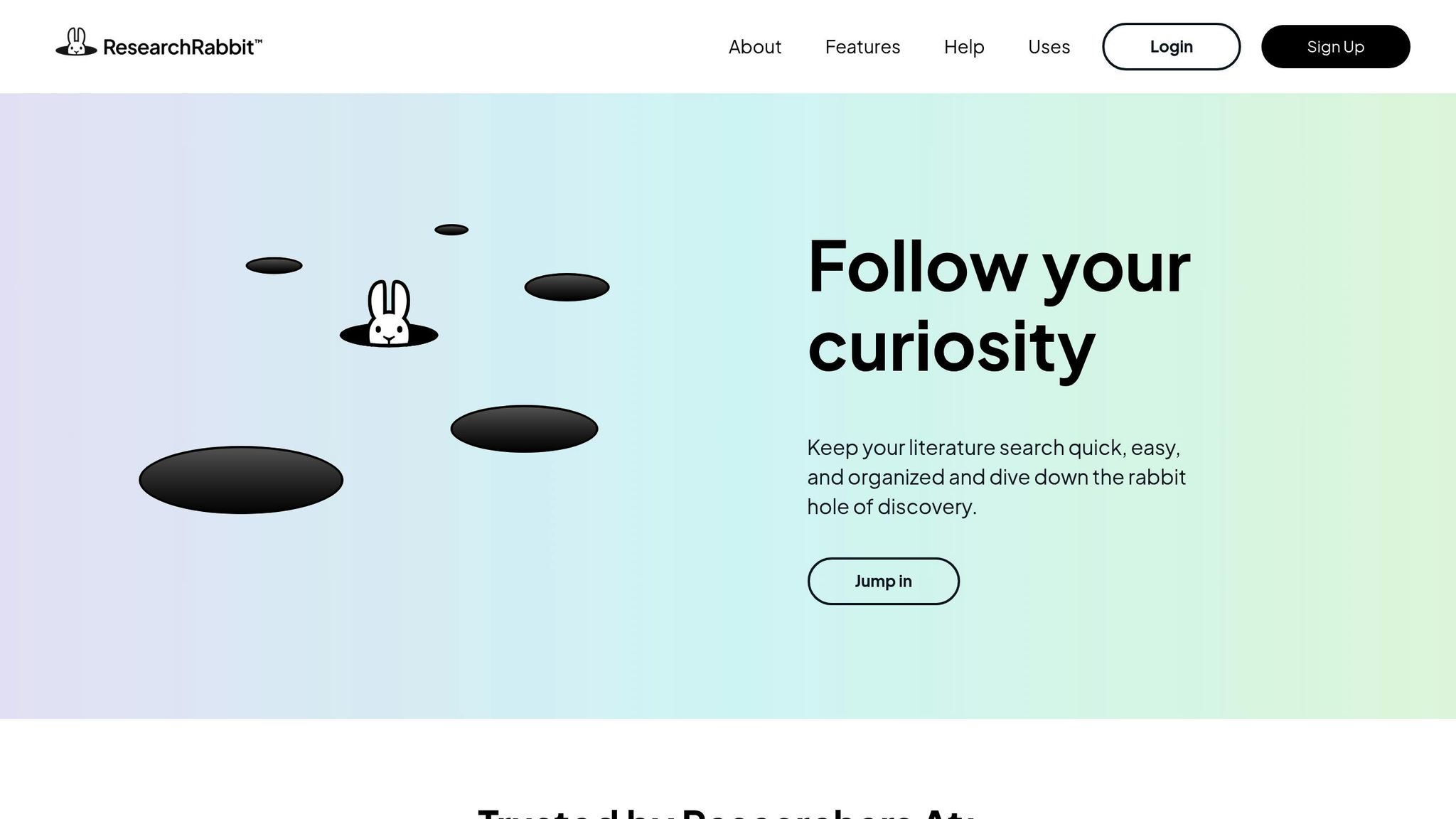
ResearchRabbit offers a fresh approach to literature discovery by visually mapping connections between papers, authors, and topics. This AI-driven tool is particularly helpful for medical researchers aiming to grasp the broader context of their field, as it highlights how studies are interlinked through citations, co-authorships, and thematic overlaps.
Core Functions
One of ResearchRabbit’s standout features is its ability to track the evolution of research, giving medical professionals a clearer view of how ideas and findings develop across studies [3]. The platform goes beyond basic keyword searches by providing smart suggestions for related research articles, ensuring users uncover papers they might otherwise miss. It also keeps researchers up-to-date by sending notifications when new, relevant studies are published.
By offering a visual representation of research connections, ResearchRabbit enhances the discovery process. This feature complements other AI tools by presenting a broader, more interconnected perspective of a research area.
Key Features
What sets ResearchRabbit apart is its visual mapping tool, which creates interactive diagrams showing relationships between papers, authors, and topics. This feature helps researchers see how various studies are interconnected and how knowledge in their field has evolved [1][3]. It’s an effective way to step back and get a "big picture" view of a research topic [3].
The platform also includes tools for discovering authors and fostering collaboration. Users can add comments, share collections, and work together to analyze relevant literature.
For added convenience, ResearchRabbit integrates seamlessly with citation management tools like Zotero, allowing users to sync their reference libraries and streamline their research workflows [1]. This integration minimizes the manual effort required to organize and manage research materials.
Pricing
ResearchRabbit operates on a completely free model, providing all its core features at no cost once you sign up [3]. This makes it an appealing option for researchers working within tight budgets or institutions looking for cost-effective tools.
That said, the platform does come with a few limitations. It doesn’t offer paper summaries, so users need to read abstracts to evaluate relevance [3]. Filtering options are also somewhat restricted, making it difficult to sort by criteria like open access availability or specific datasets [3]. Additionally, while its AI recommendations are helpful, some manual curation is still necessary to ensure the results remain accurate and relevant [3].
8. Paperpal
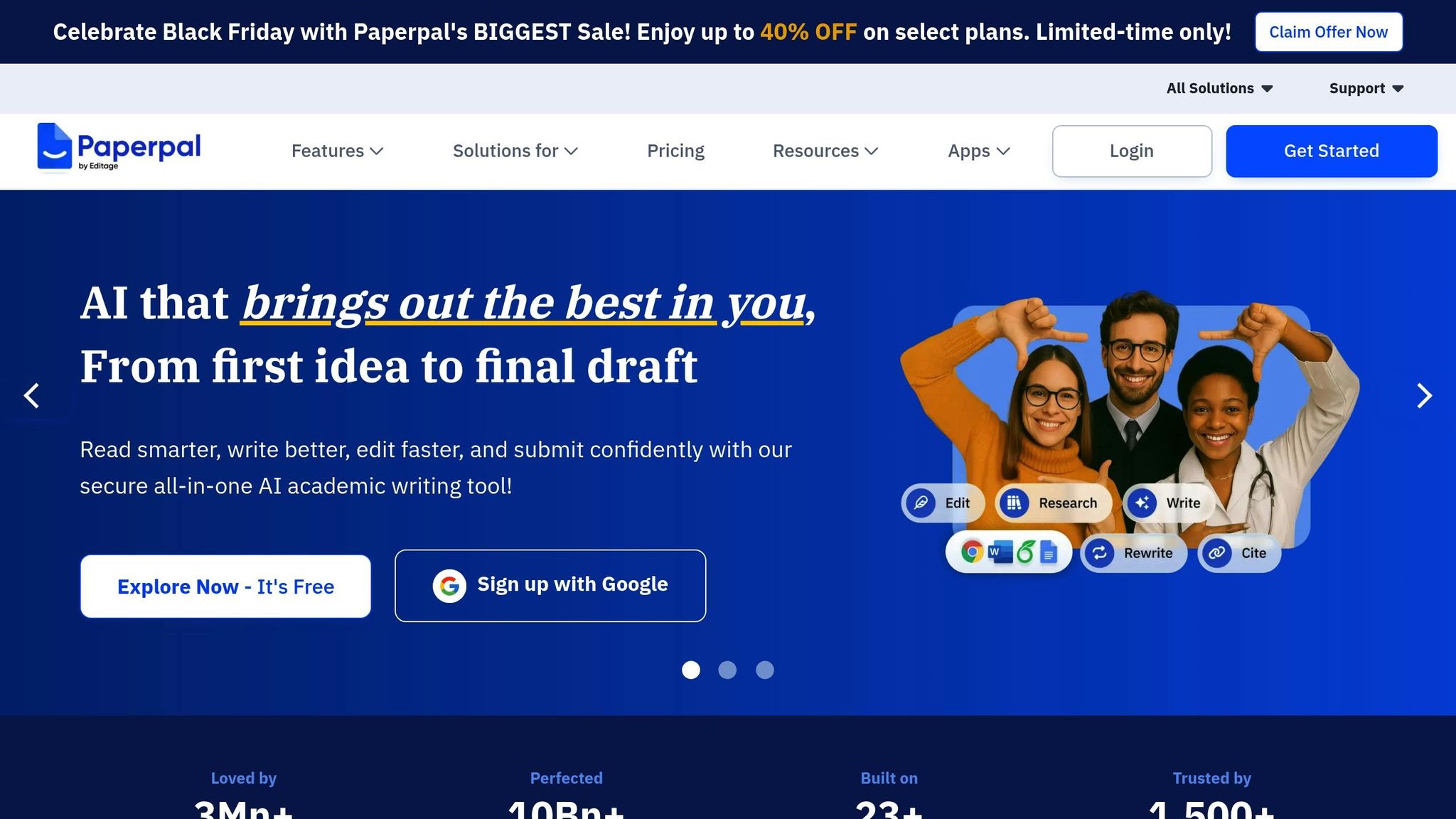
Paperpal is designed to help researchers fine-tune their scientific manuscripts, making them publication-ready. This AI-powered writing and editing tool is particularly useful for medical researchers aiming to meet the demanding standards of academic journals.
Core Functions
Paperpal stands out for its ability to improve grammar, style, and readability with real-time, subject-specific suggestions that go far beyond basic spell-checking [1][5]. It identifies complex grammar issues, offers smart rephrasing options for better clarity, and checks for structural and technical inconsistencies that could affect a manuscript’s credibility. Additionally, Paperpal reviews manuscripts to ensure they meet journal-specific guidelines, reducing the chances of desk rejections [5]. These features make it a valuable tool for streamlining the often-complicated process of manuscript preparation.
Key Features
Paperpal provides context-sensitive manuscript preparation, tailored specifically for the intricate requirements of medical publishing [1]. Its AI engine is fine-tuned for academic and research writing, delivering precise, scholarly-focused suggestions.
Some of its standout features include advanced editing tools that refine language, structure, and clarity – key for successful journal submissions [6]. It’s particularly effective for enhancing medical articles across a variety of specialties, ensuring they meet the readability and compliance standards required by medical publications [1]. Paperpal is available as both a web app and a Microsoft Word add-in, giving researchers flexibility to work in their preferred writing environment [5].
Pricing
Paperpal operates on a freemium model, offering basic features at no cost [5]. For those needing more in-depth editing support, a premium subscription is available for $9.91 per month. This plan includes unlimited grammar corrections, plagiarism checks, copilot uses, consistency checks, and submission readiness verification [5]. It’s a cost-effective option for researchers aiming to elevate their manuscripts to publication standards.
9. Covidence
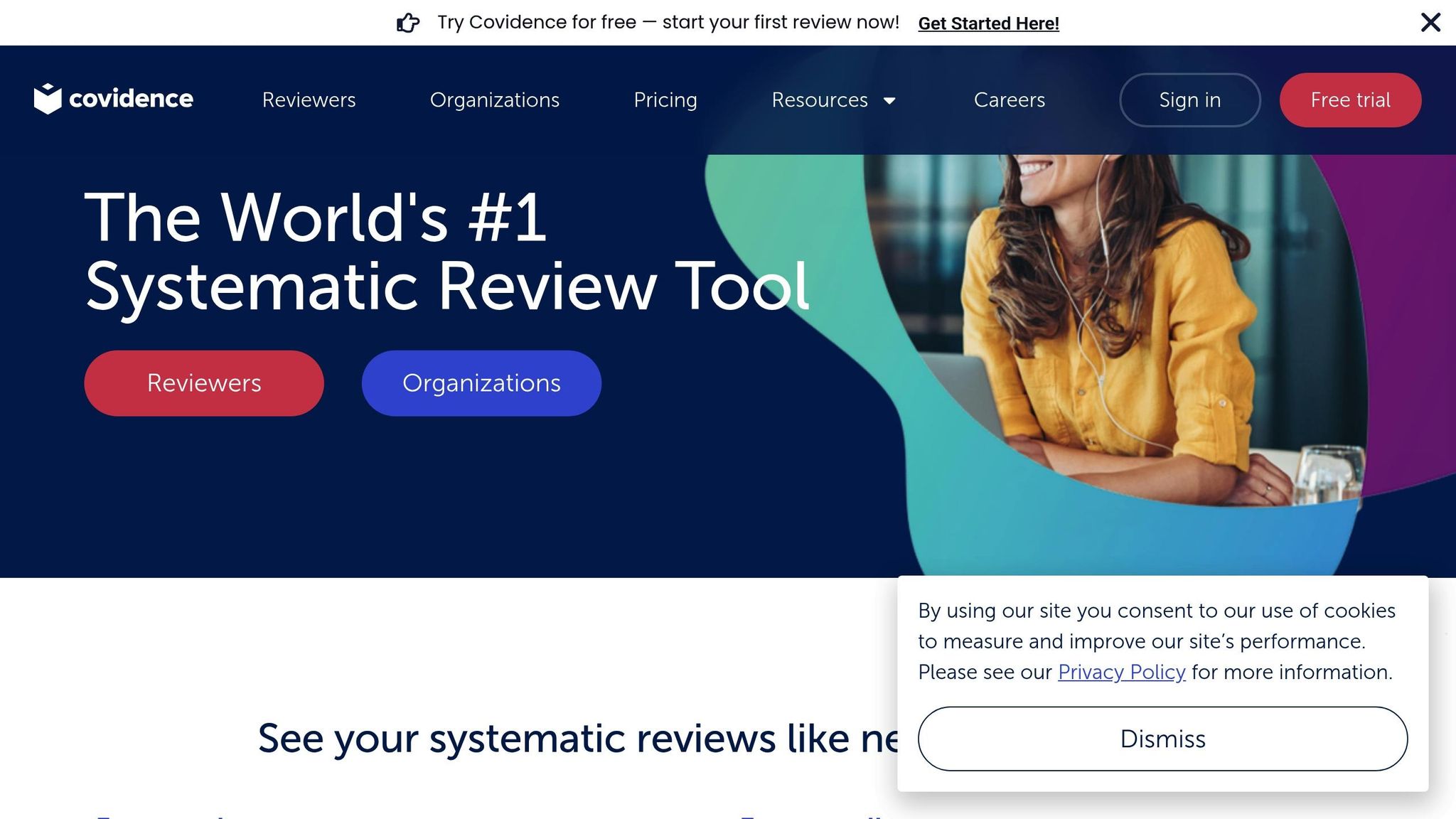
Covidence is designed to tackle inefficiencies in medical research, particularly in systematic reviews. By simplifying these reviews and meta-analyses, it reduces the manual workload and handles tasks like identifying duplicate studies, making literature evaluations far more manageable[1].
Core Functions
Covidence transforms the often time-consuming process of systematic reviews into a smoother, more streamlined workflow. With its AI-driven tools for data extraction and synthesis, it’s specifically tailored to meet the needs of medical researchers. The platform supports team collaboration, allowing multiple reviewers to independently screen studies. This "blinded screening" approach helps maintain the integrity and rigor of the review process[7][1].
Another standout feature is its ability to automatically detect duplicate studies across various databases, saving researchers significant time and effort.
These foundational tools are complemented by specialized features that further enhance the efficiency of systematic reviews.
Key Features
Covidence facilitates precise data extraction, making it ideal for detailed meta-analyses[1]. It also aids researchers in evaluating early-stage literature, helping them determine whether a research topic is oversaturated or still has room for exploration[1].
10. Aidoc

Aidoc is an AI-powered radiology platform designed to help medical researchers and clinicians quickly analyze imaging data. Its main goal is to streamline the detection of critical conditions, making it easier to manage large datasets efficiently.
Core Functions
Aidoc integrates smoothly into clinical research workflows, analyzing medical images like CT scans to identify life-threatening conditions such as brain hemorrhages, strokes, and pulmonary embolisms. By flagging these critical cases in real time, it speeds up intervention, enhances patient care, and lightens the workload for radiologists. This is particularly useful in research environments where reviewing vast amounts of imaging data is a daily challenge [8].
Key Features
The platform offers a real-time flagging system and continuous scanning, providing 24/7 monitoring without requiring constant human oversight. This automation reduces the need for manual reviews, allowing researchers to dedicate more time to complex cases. Additionally, Aidoc’s automated processes align with U.S. regulatory expectations, ensuring smooth integration into research workflows.
Integration with U.S. Standards
Aidoc adheres to U.S. healthcare regulations, including HIPAA and FDA guidelines. Researchers should confirm these compliance details directly with the provider and ensure the platform aligns with local ethical, privacy, and regulatory requirements before implementing it into their studies [1].
Advantages and Disadvantages
AI tools bring a mix of benefits and challenges to medical research, and understanding these can help researchers choose tools that align with their specific goals and financial limitations.
Take DeepWriter, for example. It’s a powerhouse for generating long, citation-heavy drafts – up to 275 pages – making it ideal for tasks like systematic reviews or meta-analyses. However, its pricing, starting at $29.00/month for the Starter plan, might be a hurdle for individual researchers or smaller organizations working on tight budgets.
On the other hand, tools like Elicit and ScholarAI automate literature searches and reviews, significantly speeding up the process. But they aren’t perfect – human oversight is still necessary to verify the results. Similarly, Scite offers valuable citation analysis by examining the context of citations, but its narrow focus means users often need additional tools to manage other research tasks.
For those who prefer a more visual approach, ResearchRabbit transforms keyword-based searches into interactive, visual maps, uncovering connections that might otherwise go unnoticed. However, this feature may feel overwhelming for researchers who prefer a more straightforward, linear workflow.
Specialized tools like Covidence stand out with features like blinded, multi-reviewer screening, which general AI tools often lack. But these advanced capabilities come with a cost, making them less accessible to smaller teams. Meanwhile, radiology-focused tools like Aidoc offer real-time imaging analysis while meeting strict U.S. healthcare standards, such as HIPAA and FDA compliance. The downside? Their utility is limited to imaging data, so users may need additional tools for other research areas.
Here’s a quick comparison of these tools, highlighting their strengths, limitations, compliance standards, and pricing:
| Tool | Core Strength | Key Weakness | U.S. Compliance | Starting Price |
|---|---|---|---|---|
| DeepWriter | Long-form research synthesis | Higher cost for comprehensive features | HIPAA-ready | $29.00/month |
| ScholarAI | Literature search automation | Requires fact validation | Standard data protection | Varies |
| Elicit | Systematic review assistance | Limited screening features | Standard data protection | Free tier available |
| SciSpace | Paper explanation and analysis | General-purpose limitations | Standard data protection | Free tier available |
| Scite | Citation context analysis | Narrow specialization | Standard data protection | Subscription-based |
| Iris.ai | Research discovery | Learning curve for new users | Standard data protection | Custom pricing |
| ResearchRabbit | Visual research mapping | Can overwhelm linear-focused researchers | Standard data protection | Free |
| Paperpal | Writing and editing support | Limited research capabilities | Standard data protection | Subscription-based |
| Covidence | Systematic review workflow | Premium pricing | Healthcare compliant | Institutional pricing |
| Aidoc | Real-time imaging analysis | Focus on imaging data only | HIPAA/FDA compliant | Enterprise pricing |
Each tool has its own niche, excelling at specific tasks like automating literature reviews, managing citations, or assisting with research synthesis. However, many platforms lack transparency in their AI processes, such as confidence scores or clear explanations for their recommendations [9].
For researchers on a budget, starting with free or lower-cost tools is a smart move before considering pricier, specialized platforms. On the other hand, institutions with more resources may find value in comprehensive platforms that combine multiple functions, ensuring seamless workflows and robust data security compliance.
Conclusion
Selecting the right AI tool for medical research hinges on your specific research goals, budget considerations, and regulatory requirements. For researchers in the U.S., compliance is especially critical – particularly when dealing with patient data or developing clinical applications.
DeepWriter is a strong choice for tasks like comprehensive research synthesis, especially if you need detailed literature reviews or meta-analyses with well-organized citations. Its ability to handle systematic reviews makes it a standout option, though its $29.00/month starting price means you’ll need to weigh it against your budget.
For those looking to manage costs, free tools like Elicit and ResearchRabbit are excellent for initial literature discovery and mapping. These platforms provide solid entry points for integrating AI into your workflow without requiring an upfront financial commitment, allowing you to explore their benefits before considering premium options.
Specialized research teams should focus on tools tailored to their primary workflows. For instance, if systematic reviews are a core part of your work, Covidence offers multi-reviewer screening features that can justify its institutional pricing. Meanwhile, for radiology-focused research, Aidoc provides FDA-compliant imaging analysis, ensuring the specialized functionality and regulatory alignment needed for clinical applications.
Navigating U.S. regulatory standards is a key consideration for any AI tool in medical research. The FDA oversees AI-enabled medical devices, and tools handling medical data may fall under SaMD regulations. Built-in compliance is not optional – it’s a necessity.
A practical approach is to start with tools that address your most time-intensive tasks. Begin with one or two platforms, then expand to more specialized solutions as your comfort with AI integration grows. Over time, you can incorporate advanced tools that offer enterprise-level features and compliance.
No single tool can cover every aspect of medical research. Consider using DeepWriter for synthesis, Scite for citation analysis, and Aidoc for imaging to create a robust and compliant research workflow tailored to your needs.
FAQs
How does DeepWriter ensure the accuracy and reliability of the research drafts it generates?
DeepWriter delivers precise and dependable research drafts by utilizing advanced AI algorithms trained on an extensive and varied collection of medical literature. This enables the tool to produce content that is both scientifically accurate and relevant to the context.
To uphold its high standards, DeepWriter incorporates thorough quality control measures. It uses natural language processing (NLP) techniques to ensure terminology remains consistent and adheres to established scientific norms. Furthermore, researchers have the option to tailor the outputs, making it possible to align the drafts with their specific objectives and requirements.
What should I consider when selecting an AI tool for my medical research and budget?
When picking an AI tool for medical research, start by pinpointing your exact needs. Are you looking for help with data analysis, conducting a literature review, or testing hypotheses? Look for features that align with these goals – things like summarization tools, citation management, or advanced analytics can make a big difference.
Pricing is another key factor. Check if the tool fits your budget. Many tools offer free versions with limited features, while others require a subscription for more robust options. Aim for a tool that meets your research needs without stretching your finances too thin.
Finally, think about how easy the tool is to use and whether it works well with your current setup. A tool with an intuitive interface and smooth integration into your workflow can save you time and keep your focus where it belongs – on your research.
What regulatory or compliance factors should I consider when using AI tools in medical research?
When using AI tools in medical research, it’s crucial to follow all relevant regulations and ethical guidelines. In the U.S., this means complying with HIPAA (Health Insurance Portability and Accountability Act) to protect patient privacy and data security. If the AI tool qualifies as a medical device, you’ll also need to account for FDA regulations.
On top of that, your research must meet the standards set by institutional review boards (IRBs) and adhere to ethical principles for studies involving human participants. Key factors include being transparent about how data is used, obtaining proper consent, and ensuring algorithms remain free from bias to align with both legal and ethical requirements.
